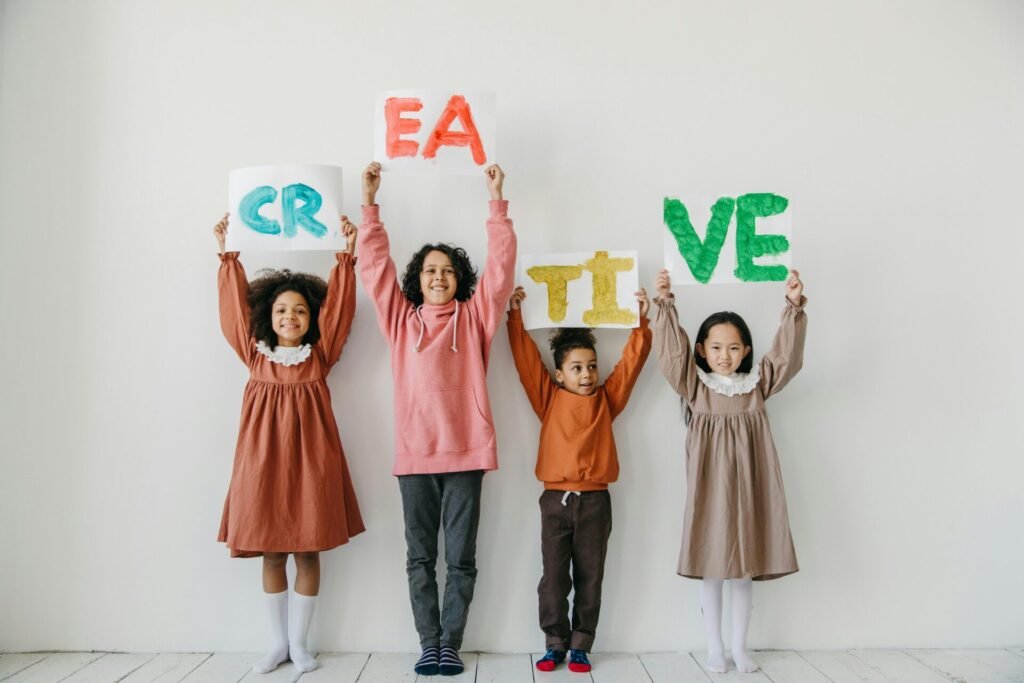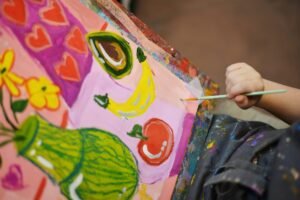Art Builds Emotional Intelligence and Self-Regulation
Art is often celebrated for its ability to spark imagination and self-expression—but its impact goes far deeper. Understanding how art benefits your child’s development beyond creativity can help parents support their child’s growth in ways that extend into emotional intelligence, academic readiness, and lifelong learning. From sketchbooks to sculpture, artistic experiences shape the whole child.
A Safe Outlet for Expression
Children often struggle to articulate complex emotions. Art provides a nonverbal language for feelings like frustration, joy, or anxiety. Through drawing, painting, or sculpting, kids can externalize what they’re feeling in a safe and constructive way.
This emotional release helps them process experiences and develop self-awareness. Over time, they learn to recognize and regulate their emotions—skills that are essential for healthy relationships and mental well-being.
Sketchbooks as Emotional Journals
A sketchbook can become a private space for emotional exploration. Unlike a finished art project meant for display, a sketchbook is personal and pressure-free. Children can return to it daily, using it to draw moods, record dreams, or simply doodle through difficult feelings. This habit encourages reflection and builds emotional resilience.
Art Enhances Cognitive Development and Problem-Solving
Strengthening Brain Connections
Art engages both hemispheres of the brain. While the right side fuels imagination and visual thinking, the left side supports planning, sequencing, and logic. Activities like mixing colors, designing compositions, or building 3D models require children to make decisions, test ideas, and adapt when things don’t go as planned.
These experiences sharpen executive function skills—such as working memory, flexible thinking, and impulse control—that are critical for academic success.
Encouraging Critical and Divergent Thinking
Unlike subjects with clear right or wrong answers, art invites multiple solutions. A child deciding how to shade a drawing or construct a paper sculpture is practicing divergent thinking—the ability to generate creative solutions to open-ended problems. This kind of thinking is foundational in STEM fields and innovation-driven careers.

Sketchbooks.org | TIPS AND HACKS
Best Portable Sketching Tools | Traditional & Modern Essentials for Artists
Whether you're sketching on a train, in a café, or deep in the woods, having the right portable sketching tools can make all the difference. Today’s artists are no longer confined to studios—creativity happens anywhere....
Art Supports Language and Communication Skills
Visual Storytelling and Verbal Expression
When children create art, they often want to explain it. Describing their work builds vocabulary, sequencing, and narrative skills. Whether they’re telling you about a dragon they drew or a scene they painted, they’re practicing communication in a meaningful context.
Group art activities also encourage collaboration and listening. Children learn to share materials, take turns, and offer feedback—skills that translate directly to classroom and social settings.
Sketchbooks as Story Starters
A sketchbook can double as a visual diary or storybook. Kids can create characters, illustrate scenes, or map out imaginary worlds. These drawings often become the seeds of written stories, helping reluctant writers find their voice through images first.
Art Improves Fine Motor Skills and Coordination
Hands-On Learning Through Materials
Cutting, gluing, painting, and drawing all require precise hand movements. These actions strengthen the small muscles in the hands and fingers, improving coordination and control. Over time, this supports handwriting, typing, and even tasks like tying shoes or using utensils.
Art also enhances hand-eye coordination. Whether a child is tracing a shape or filling in a detailed pattern, they’re learning to synchronize vision and movement—an essential skill for sports, music, and daily life.
Art Fosters Confidence and Independence
Ownership of the Creative Process
When children make art, they’re in charge. They choose the colors, the subject, the materials. This autonomy builds confidence and a sense of agency. Even when a project doesn’t turn out as expected, the act of trying, adjusting, and finishing teaches perseverance.
Displaying their work—on the fridge, in a frame, or in a personal sketchbook—reinforces that their ideas are valuable. Over time, they begin to see themselves as capable creators, not just consumers.
Encouraging Risk-Taking and Resilience
Art teaches that mistakes aren’t failures—they’re part of the process. A smudged line or torn paper becomes an opportunity to adapt. This mindset encourages risk-taking and reduces fear of failure, both of which are essential for growth in any field.
Frequently Asked Questions
How does art help with emotional development?
Art gives children a safe way to express and process emotions they may not yet have words for.
Can art improve academic performance?
Yes, art strengthens cognitive skills like memory, focus, and problem-solving that support learning across subjects.
What role does a sketchbook play in development?
A sketchbook encourages daily creativity, emotional reflection, and visual storytelling in a pressure-free format.
Is art beneficial for children who struggle with communication?
Absolutely—art offers a nonverbal outlet that can help children express themselves and build confidence.
How does art support fine motor development?
Activities like drawing, cutting, and painting strengthen hand muscles and improve coordination.
Should I correct my child’s artwork?
No—focus on encouraging effort and exploration rather than perfection or technique.
What if my child loses interest in art?
That’s normal. Offer new materials or experiences, but let them return to it on their own terms.
Can digital art offer the same benefits?
Digital tools can support creativity, but hands-on materials offer tactile learning that’s especially valuable in early development.
Final Thoughts
Understanding how art benefits your child’s development beyond creativity reveals just how powerful a paintbrush—or a sketchbook—can be. Art nurtures emotional intelligence, cognitive growth, communication, and confidence in ways that ripple through every area of life.
As a parent, you don’t need to be an artist to support your child’s journey. Just provide the space, the tools, and the encouragement to explore. Let their sketchbook be a playground for ideas, a mirror for emotions, and a record of growth. Because when children are free to create, they’re also learning how to think, feel, and thrive.
Ready to Share Your Work?








I always thought of art as “extra.” But it’s essential.
My kid struggles with words—but through drawing, we’ve had whole conversations.
ART supports emotional regulation and problem-solving